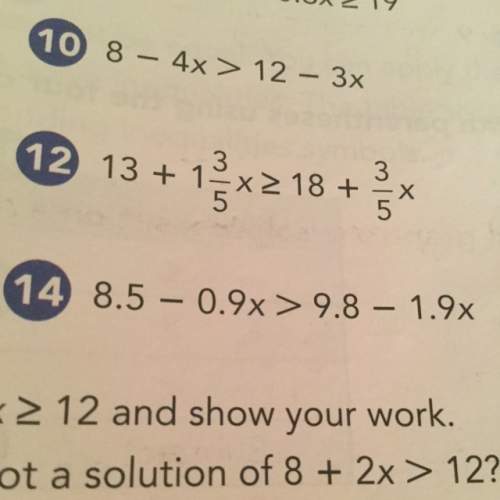
Mathematics, 18.07.2019 10:10 mmczora22
You have learned that a hot object will cool down over time according to newton’s cooling model. you can perform your own investigation to see this model first hand. materials: you will need: hot coffee or tea (can also be just hot water) thermometer (if you do not have access to a thermometer, read the procedure and then use the sample data given below.) pencil and paper procedure: obtain a hot cup of coffee/tea/cocoa/water. record the initial temperature of the liquid. note the time you take the temperature. every 15 minutes, record the temperature of the liquid. do this 8 times (total of 2 hours elapsed). data analysis: record your time and temperature in the chart below.

Answers: 1
Another question on Mathematics

Mathematics, 20.06.2019 18:04
On a coordinate grid, point p is at (4, 3) and point r is at (−2, −5). points q and s are a reflection of both points across the x-axis. what are the coordinates of q and s? q(−4, 3), s(2, −5) q(4, −3), s(−2, 5) q(−4, −3), s(2, 5) q(−4, 3), s(−2, 5) ; -; i can't figure it out, if someone can me with the answer,that would be nice
Answers: 2

Mathematics, 21.06.2019 20:40
Askate shop rents roller skates as shown on the table below. which graph and function models this situation?
Answers: 1


Mathematics, 22.06.2019 03:00
In this problem, we explore the effect on the standard deviation of multiplying each data value in a data set by the same constant. consider the data set 14, 6, 8, 15, 15. (a) use the defining formula, the computation formula, or a calculator to compute s. (round your answer to one decimal place.) s = 4.28 (b) multiply each data value by 3 to obtain the new data set 42, 18, 24, 45, 45. compute s. (round your answer to one decimal place.) s = 12.83 (c) compare the results of parts (a) and (b). in general, how does the standard deviation change if each data value is multiplied by a constant c? multiplying each data value by the same constant c results in the standard deviation remaining the same. multiplying each data value by the same constant c results in the standard deviation being |c| times as large. multiplying each data value by the same constant c results in the standard deviation increasing by c units. multiplying each data value by the same constant c results in the standard deviation being |c| times smaller. (d) you recorded the weekly distances you bicycled in miles and computed the standard deviation to be s = 3.8 miles. your friend wants to know the standard deviation in kilometers. do you need to redo all the calculations? yes no given 1 mile ≠1.6 kilometers, what is the standard deviation in kilometers? (enter your answer to two decimal places.)
Answers: 1
You know the right answer?
You have learned that a hot object will cool down over time according to newton’s cooling model. you...
Questions

Social Studies, 30.09.2019 22:00


















Computers and Technology, 30.09.2019 22:00




